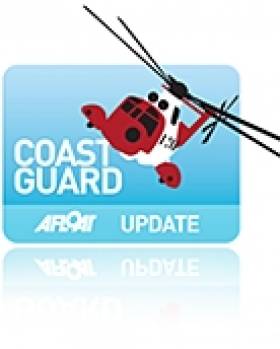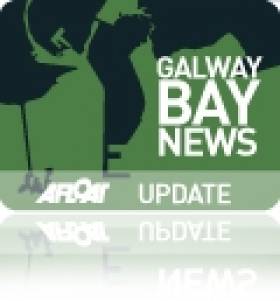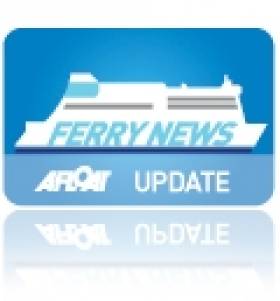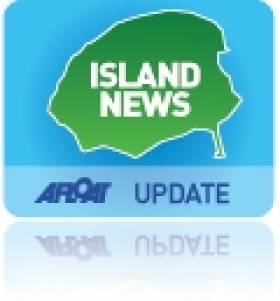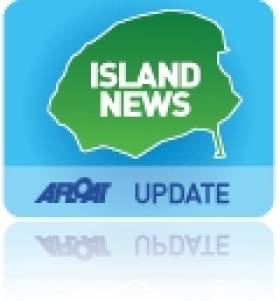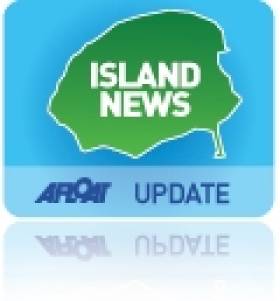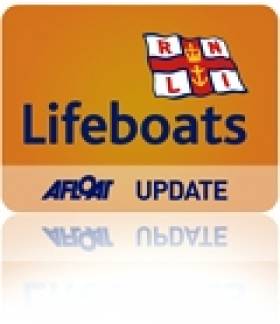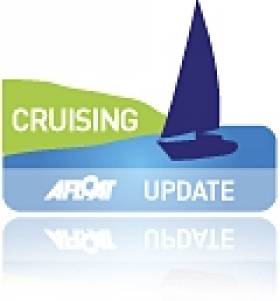Displaying items by tag: Aran Islands
#Coastguard - The HSE has been criticised for deploying two Irish Coast Guard helicopters to the Aran Islands for injured woman who could have been transported to hospital by a commercial flight.
The Irish Times reports that the HSE West has defended its actions in deploying successive rescue helicopters to airlift the elderly tourist as part of the coastguard's air ambulance service, despite the Inis Mór GP who treated her broken ankle describing the injury as not serious.
But the National Ambulance Service does not have a contract with Aer Arann, which operates commuter plane flights in the islands, necessitating a medevac by coastguard helicopter at an estimated total cost of €7,000.
The Irish Times has more on the story HERE.
#rnli – RNLI lifeboat crew with Aran Islands RNLI will be able to launch their all weather Severn Class lifeboat faster following the installation of a 24 metre pontoon, which will enable the lifeboat crew to board the lifeboat from a newly installed berth. The new stable platform will also ensure that the transfer of casualties onto or from the lifeboat can be done more easily and safer.
The 56 tonne structure is situated in the harbour between the new breakwater and the original pier. The enormous structure was transported to the island by ferry and carefully manoeuvred into place for fit out over a couple of weeks.
The work brings to completion a major building project on Inis Mór which has also seen a new lifeboat station built on the site of the old one, giving the volunteer lifeboat crew better facilities including a crew changing area and training room. It represents a significant investment by the charity for the island based lifeboat station, which has been in existence since 1927.
Speaking on the recent works RNLI Divisional Operations Manger Owen Medland said, 'this development makes the operation of the Aran Islands lifeboat safer for the crew. Maintenance is easier with shore power and water close at hand. Also most importantly the transfer and handling of casualties can be done with minimum disruption and on the shore. It is also safer for the lifeboat crew who can be responding in the middle of the night and in all weathers to life and death situations. This new pontoon does away with the need of a boarding boat to transfer the crew out to the middle of the harbour to board the lifeboat. It has been a long wait but we are all delighted to finally see the Aran Islands RNLI crew and supporters provided with appropriate modern facilities.'
Aran Islands RNLI Coxswain John O'Donnell added, 'This is a very welcome development for the lifeboat station and the whole community. Many of our callouts are medical evacuations and to have this new stable berth for the lifeboat means that a casualty can be safety moved with a minimum of discomfort. It will also shave a few minutes off our launch times which in some search and rescue situations can be vital.'
Six More Months Before Any Decision On Galway Bay Fish Farm
#FishFarm - Any decision on the proposed deep-sea organic salmon farm for Galway Bay is at least six months off, as Galway Bay FM reports.
That was the message from the Department of the Marine after Galway TD Eamon O'Cuiv raised the matter in the Dáil this week.
Previously the Fianna Fáil deputy for Galway West had called on Bord Iascaigh Mhara (BIM) to withdraw its application for the 500-hectare fish farm off Inis Oírr in the Aran Islands in light of dispute over the potential impact of sea lice on the region's wild salmon stocks.
His call, in turn, came after the European Commission halted progress on BIM's plans last November amid concerns regarding scientific studies on the impact of disease at what would be the largest aquaculture scheme of its kind in Europe.
Winter Ferry To Inis Mór Could Be No More
#AranIslands - Galway Bay FM reports on fears that winter ferry services to Inis Mór in the Aran Islands might end due to lack of Government funding.
Galway Senator Fidelma Healy Eames raised the issue in the Seanad last week, telling how the Galway Bay islanders have been lumped with travel and fare increases since the ceasing of a State-subsidised contract for Inis Mór's passenger ferry, and the failure to receive tenders for a new five-year contract.
It's already been reported that ferry visits to the Aran Islands have fallen by 20% in six years.
Aran Islands Ferry Visits Drop By A Fifth
#IslandNews - Galway Bay FM reports that ferry visits to the Aran Islands have fallen by 20% in six years.
The latest numbers show that fewer than 160,000 people made the trip from Rossaveal in Connemara to the Galway Bay island chain in 2013, compared to the more than 222,000 who made the journey in 2007.
Reduced ferry services to the islands, as well as a general drop-off in tourism to the West of Ireland, have been suggested as possible causes.
Aran Islander Fishes A Lotto Jackpot
#Jackpot - Galway Bay FM reports that a fisherman from the Aran Islands is celebrating a €350,000 windfall from the National Lottery.
The lucky islander collected his winnings incognito from the Lotto offices in Dublin yesterday 2 December after winning the Lotto Plus 1 draw on 9 November with a ticket bought in Limerick.
Aran Islanders Represent Ireland In China
#IslandNews - Residents of the Aran Islands are currently in China accompanied by the mayor of Co Galway for a worldwide competition that's doubling as an opportunity to market the West of Ireland as a tourism destination.
The delegation from Inis Oírr are in the southeast coastal city of Xiamen representing Ireland in the 'sustainable communities' category of the Pride of Place competition, according to Galway Bay FM.
Aran Islands Lifeboat Launches To Grounded Yacht
#RNLI - Galway Bay FM reports that the Aran Islands RNLI lifeboat was tasked to assist a yacht that ran aground off Inis Mór in the Galway Bay island chain yesterday afternoon (23 August).
The yacht apparently got into difficulty in Killeany Bay while approaching Kilronan harbour, but the lifeboat crew soon helped it get on its way again, and all four people on board were safe and well.
Elsewhere, Portaferry RNLI was called out in the early hours of Thursday morning (22 August) to rescue two people stranded on an island at the north end of Strangford Lough.
The two adults, a man and a woman, had become stranded on Island Hill, a small island which lies just offshore in Strangford Lough between Newtownards and Comber in Co Down.
The island is accessible on foot at low tide via a concrete causeway connecting the mainland to the small island, but the couple had been cut off when the causeway became submerged due to the incoming tide.
Both were taken on board the lifeboat and taken to a nearby car park where they were they were passed into the care of the local coastguard.
#FishFarm - Bord Iascaigh Mhara (BIM) has responded to concerns from environmental groups that an ingredient in treatments for sea lice in salmon farms poses a threat to wild marine life.
As Galway Bay FM reports, campaigners Galway Bay Against Salmon Cages - one of the groups opposed to the planned Galway Bay fish farm - say that cypermethrin, an active ingredient in veterinary medicine used to treat sea lice, is toxic to aquatic organisms.
BIM aquaculture manager Donal Maguire attempted to play down fears over the use of the pesticide, saying it has been fully tested for toxicology in the marine environment.
However, another campaign group claims BIM's position is contrary to the manufacturer's own warnings on the use of the drug.
According to FishNews.eu, Friends of the Irish Environment (FIE) cited the Irish Medicines Board's product description for cypermethrin, which states that it is "dangerous to fish and other aquatic life" and demands that the chemical "should not be allowed to contaminate water".
FIE went on to describe cypermethrin as "a biocide which kills life, not a medicine that saves lives" and as "a highly active neurotoxin" with "known effects on fish and, most sensitive of all, crustaceans such as crabs and lobsters. Bathers and watersports [enthusiasts] may also be at risk."
Earlier this month, Inland Fisheries Ireland (IFI) expressed "serious concerns" over the findings of a study on wild salmon in Ireland that claimed fish farm schemes were less harmful to wild fish than pollution and possibly even beneficial to wild catchments.
IFI is among the significant opposition to BIM's proposed organic salmon farm off the Aran Islands, a 500-hectare project that would be the largest of its kind in Europe and create hundreds of jobs in the locality.
Record Fleet Sail to Aran Islands
#aranislands – A record fleet descended on the recently extended harbour at Kilronan in the Aran Islands last weekend (July 5-7) in an initiative co-ordinated by Pierce Purcell of Purcell Marine in Clarenbridge, with John O'Malley rounding up the North Shore fleet. With the all-embracing title of the Galway Afloat West Coast Gathering Cruise-in-Company, just about every option was covered, and the west coast fleets responded with enthusiasm.
In all, boat numbers topped the 50 mark, with the main group sailing from within Galway Bay to bring 37 boats west to the Inishmore and the hospitality of Kilronan. As well, there were others from Ballyvaughan and Connemara, but more impressively the event attracted cruisers from the Shannon Estuary, Fenit and Dingle, while a cruiser from Barcelona on Spain's Mediterranean coast found herself involved as she'd sailed into Kilronan from the Azores to find a right come-all-ye getting under way.
On the Saturday, 15 young sailors from the new Sailing Club in Kilronan (where the Commodore is Michael Gill) joined with members of Galway Bay SC for a taste of inshore racing, and an impromptu prize-giving in Ti Joe Watty's rounded out the sport.
The hospitality was the high point of the weekend, with the welcome led by Kilronan Harbour Master Patrick McDonagh, who had been liaising with Galway Harbour Master Brian Sheridan. On the island, the celebrations at Ti Joe Watty's were well matched by the fine food provided by P J and Grace Flaherty, and through Sunday, it was a very contented fleet which dispersed towards their many home ports. It had been an impressive turnout, but Pierce Purcell isn't one to rest on his laurels. He notes that his Galway Afloat database lists 220 boats in the region, so he'll be rattling some cages to get more of them into action and availing of the wonderful sailing waters of the west with more events like this.


























